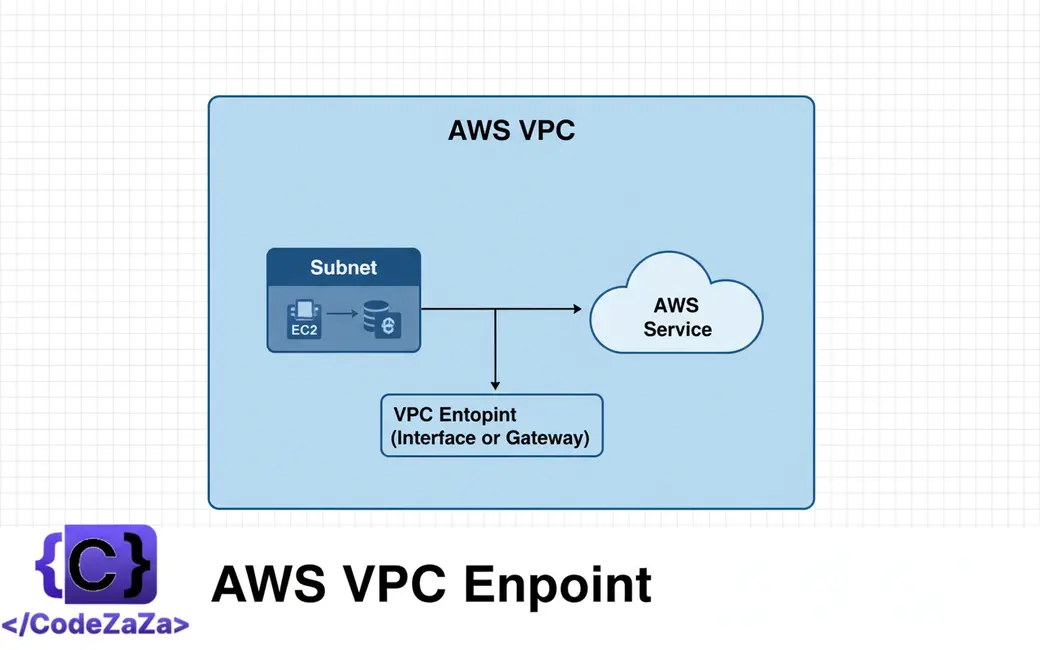Before introducing VPC Endpoint, even if your resources were in a private subnet, they had to go through the internet or use a NAT Gateway to reach AWS services. This increases cost, security risks, and slows down connections. For solving these issues, AWS VPC comes in.
With AWS VPC Endpoint, your application can connect to AWS services privately and securely without using the internet, a NAT gateway, VPN, or Direct Connect. Now, everything will stay within the AWS network, which makes it faster, more secure, and cheaper. It’s a great way to improve your cloud setup, especially for businesses that need strong performance and security.
Why Should You Use VPC Endpoints in AWS?
In modern cloud environments, security, cost optimization, and performance are top priorities. AWS VPC Endpoints provide private and secure connectivity to AWS services without exposing traffic to the public internet. Let’s explore the key reasons why you should use VPC Endpoints in your AWS infrastructure.
1. Cost Reduction
When you access AWS services like Amazon S3 or DynamoDB without VPC Endpoints, the traffic flows through NAT Gateways, Internet Gateways, or VPNs. This increases both infrastructure and data transfer costs. By using VPC Endpoints, you can eliminate these additional charges and reduce AWS networking expenses, making your architecture more cost-efficient.
2. Enhanced Security
With AWS VPC Endpoints, your applications communicate securely within the AWS private network without routing through the public internet. This reduces the risk of cyber threats such as:
- DDoS attacks
- Data interception
- Unauthorized access
By minimizing internet exposure, VPC Endpoints significantly improve the security posture of your cloud environment.
3. Improved Application Performance
VPC Endpoints connect your VPC directly to AWS services, avoiding external internet networks. This leads to:
- Lower latency
- Faster response times
- Higher reliability
The result is better application performance, which is especially important for real-time applications, big data workloads, and high-traffic web services.
4. Easy Configuration
VPC Endpoints integrate smoothly with IAM policies, route tables, and security groups, allowing you to manage access control without major network reconfiguration. This makes deployment simpler and more efficient.
AWS VPC Endpoints Architecture
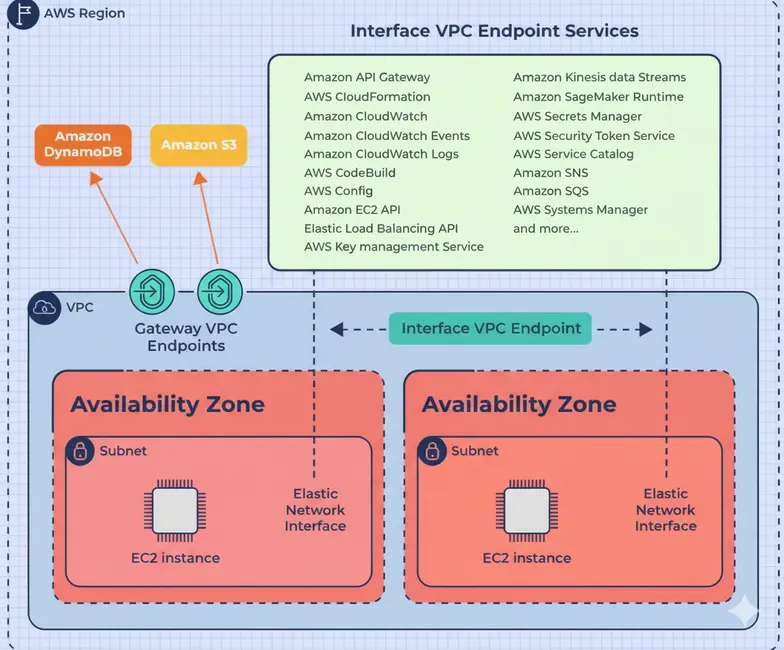
AWS VPC endpoints provides a secure and private communication between the resources within the Amazon VPC and AWS Services without having the requirement of Internet access. They comes with consisting interface endpoints for the AWS services through which the services can be accessed through the private links and gateway endpoints for Amazon S3 and DynamoDB. It uses Elastic Network Interfaces (ENIs) for connectivity. Through it’s architecture it facilitates enhanced security within the AWS network and improves the performance by reducing the latency and bandwidth constraints associated with internet based communication.
How AWS VPC Endpoints Work?
VPC endpoints use Elastic Network Interfaces (ENIs) to securely connect resources inside your VPC to AWS services. These endpoints essentially act as virtual network devices, providing high availability and scalability within your VPC.
There are two types of VPC endpoints we’ve:
- Gateway Endpoints
- Interface Endpoints
1. Gateway Endpoints
A VPC Gateway Endpoint is a way to connect your VPC to an AWS service like S3 or DynamoDB without going through the public internet or need to set up a VPN connection. This helps improve security and can also improve network performance since the traffic stays within the AWS network.
So if we want to utilize S3 or DynamoDB services inside VPC then Gateway Endpoints is recommended over Internet Gateway , NAT, or any other service, as this method also improves security, and latency for the application traffic.
How to Set Up Gateway Endpoints?
To successfully set up a gateway endpoint, here are the steps you need to follow:
Choose the AWS Service
Start by deciding which AWS service you want to connect with, either Amazon S3 or DynamoDB. This choice will dictate the type of gateway endpoint you’ll be creating.
Select Your VPC
Identify the Virtual Private Cloud (VPC) where you wish to deploy the gateway endpoint.
Identify Route Tables
Locate the route table(s) within the chosen VPC that you will link to the gateway endpoint. These route tables will be updated with the necessary information to allow access to the selected AWS service.
Define an Access Policy
Create an access policy for the endpoint. This policy outlines which resources—like S3 buckets or DynamoDB tables—can be accessed and what actions can be taken by the components within your subnets. It plays a crucial role in managing and controlling access to the AWS service.
Configure Security Group Rules
Check that the security group linked to your resources includes a rule that allows outbound traffic to the chosen service (S3 or DynamoDB). This step is vital to ensure that data can flow through the gateway endpoint and that your components can effectively communicate with the AWS service.
2. Interface Endpoints
Interface endpoints enable connectivity to services over AWS PrivateLink. These services include some AWS managed services, services hosted by other AWS customers and partners in their own Amazon VPCs (referred to as endpoint services), and supported AWS Marketplace partner services. The owner of a service is a service provider. The principal creating the interface endpoint and using that service is a service consumer.
How to Set Up Interface Endpoints?
To create an interface endpoint, you can follow these straightforward steps:
Select the AWS Service
Start by identifying the specific AWS service or endpoint service you want to connect with privately.
Create a Network Interface
Set up an Elastic Network Interface (ENI) and choose the appropriate subnet to link with the interface endpoint.
Assign a Private IP Address
The interface endpoint will automatically receive a private IP address from the range of the selected subnet. This address will stay associated with the endpoint until it is deleted.
Utilize the Private IP Address
By using this private IP address, all traffic can remain within the Amazon network, which means you won’t need to make any alterations to the route table.
What are Shared Subnets?
Shared subnets in AWS are part of a feature called VPC Sharing, which allows multiple AWS accounts within the same organization to use the same Virtual Private Cloud (VPC). In this setup, one AWS account, known as the host account, creates and manages the VPC along with its subnets. This account then shares specific subnets with other AWS accounts, called participant accounts, using AWS Resource Access Manager (RAM). The participant accounts can launch and manage their own resources—like EC2 instances, Lambda functions, or RDS databases—directly into the shared subnets. However, the host account maintains control over the network settings, such as route tables, network ACLs, and security configurations. This setup is especially useful in large organizations where the networking team can manage the VPC centrally, while different teams or departments can deploy applications independently.
Example: if a company has a networking team and an application team, the networking team can create a shared VPC and subnets, and the application team can use those subnets to deploy their services. This approach helps improve security, simplifies management, and ensures better compliance across all environments.
How to Create AWS VPC Endpoints?
The following are the step by step guide for creating AWS VPC Endpoints:
Prerequisite:
vpc along with 1 public and private subnet and inside the subnet already Virtual machine is launched.
Step 1: Login in to AWS Management Console
- Go the AWS Management Console of AWS Account and login with your credentials
- After login in to your Account you will be landed on the Console Home.
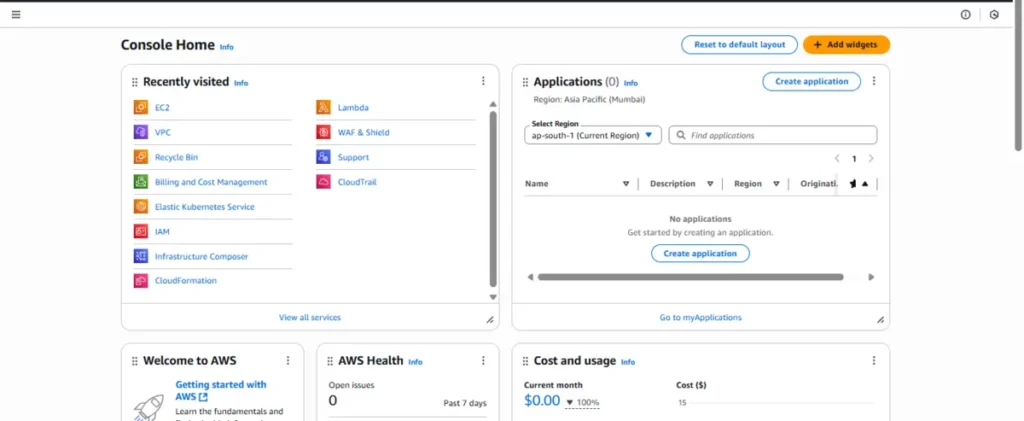
Step 2: Navigate to AWS VPC Dashboard
- Search for “AWS VPC” in the search panel.
- On clicking on AWS VPC, you will be directed to AWS VPC Dashboard Page.
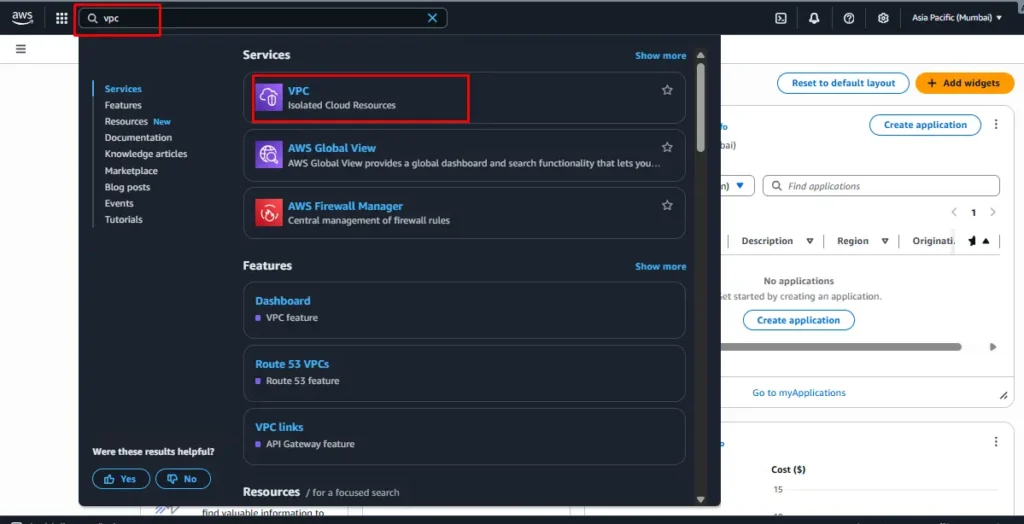
Step 3: Select Endpoints from the Navigation Pane
- In this VPC Dashboard, locate to the “Endpoints” option in the navigation pane.
- Choose the VPC Endpoints at the left panel. Click on Create Endpoint.

Step 4: Create Endpoint
- On Clicking on the create Endpoint button, it starts the creation process of endpoint.

Step 5: Choose Service
- Select the AWS service for which you want to create a VPC Endpoint such as it can be any AWS Services like Amazon S3, AWS DynamoDB or others. Here we are choosing Amazon S3 in particular ” com.amazonaws.ap-south-1.s3
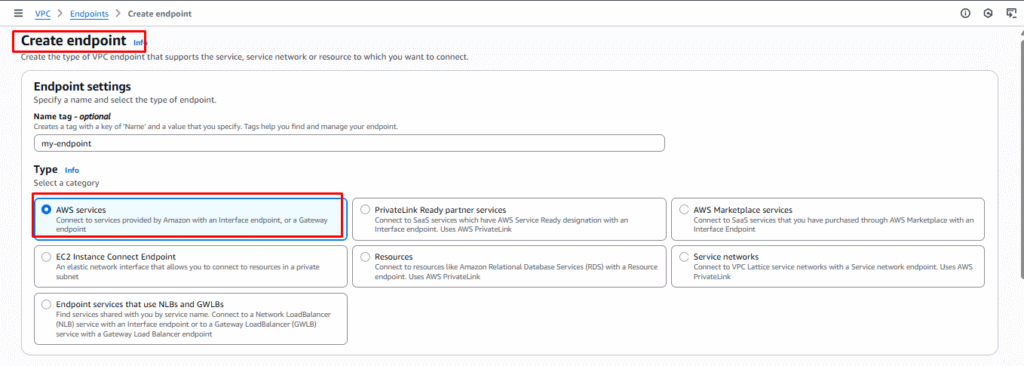

Step 6: Configure Endpoint
- Configure the endpoint settings including the VPC and subnet where the endpoint should reside and any security groups to attach to the endpoint.
- Update the Policy if you wanna restrict access through this endpoint or else leave Full Access. Click on Create.
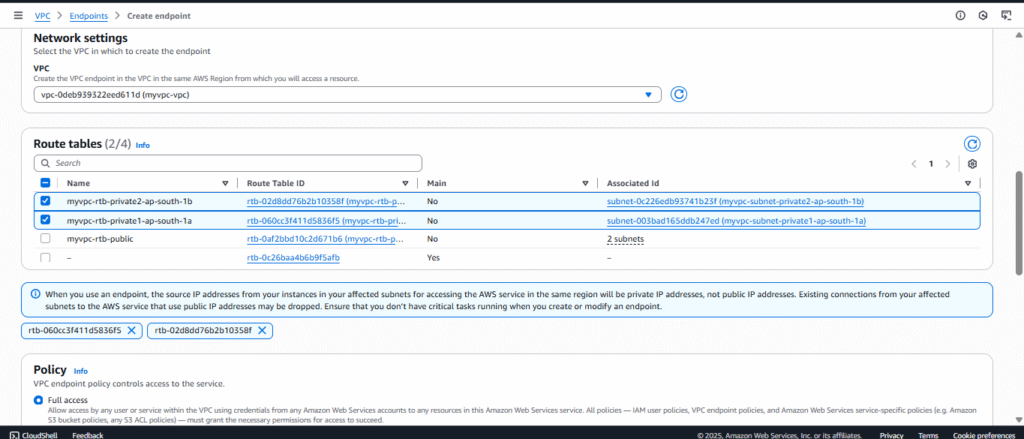
Endpoint route, and now you will be able to interact with S3 Service, here instead of traversing the traffic through a After attaching the endpoint to the route tables, the subnets which have that route table will have access to S3 now.
Step 7: Review and Create
- Now we can create an EC2 instance with the VPC and the subnet which has an Amazon S3 public IP address (internet), it will be traversed via VPC endpoint.
Step 8: Verify Endpoint Creation
- Once the endpoint has created, verify its status in the Endpoints dashboard. It should shows as “Available” if the creation was successful.
Step 9: Test Endpoint
- Finally test the endpoint by attempting to access the associated AWS Service from the resources within your VPC. If you configured the correctly the endpoint should allow secure and private communication with the AWS Service without requiring the internet access
AWS Services Supporting VPC Endpoints
The following table shows the list of different AWS Services that supports VPC Gateway Endpoint and Interface Endpoint:
| AWS Service | Supports Gateway Endpoint | Supports Interface Endpoint |
|---|---|---|
| Amazon S3 | Yes. | No |
| Amazon DynamoDB | Yes | No |
| Amazon SNS | No | Yes |
| Amazon SQS | No | Yes |
| AWS Lambda | No | Yes |
| AWS Secrets Manager | No | Yes |
| AWS Systems Manager | No | Yes |
| Amazon Kinesis | No | Yes |
| AWS Step Functions | No | Yes |
What is a VPC Endpoint Policy?
A VPC Endpoint policy is a resource-based IAM policy that controls who can access AWS services through a VPC Endpoint. It gives permissions to only authorized users, roles or services to interact with AWS resources privately within your Virtual Private Cloud(VPC). By default, a VPC Endpoints grants you full access to the connected AWS service, but you can restrict access using a custom VPC Endpoint Policy.
VPC Endpoint Security Best Practices
To ensure secure, optimized, and cost-effective use of VPC Endpoints, follow these best practices:
1. Try to Avoid Unnecessary Usage of Endpoints
You should use VPC endpoints only when required it would save or reduce your cost.
Example: Suppose your team is working on any project where you are using S3, DynamoDB, SNS, SQS,Lambda etc. Gateway Endpoints for S3 and DynamoDB are free, but Interface Endpoints (for SNS, SQS, Lambda, etc.) cost money. If your team doesn’t need an Interface Endpoint, try to avoid keeping it active to save your money.
2. Restrict Access with Security Groups
For Interface Endpoints, use strict security group rules so it will allow only those IPs or applications which you allow.
Example: Imagine you have a private messaging system that uses Amazon SQS (a queue service) to handle messages between applications. Instead of allowing anyone to access the SQS queue, you should set up Security Groups to allow access only from your trusted application servers’ IP addresses. This way, only your servers can send and receive messages, keeping your data safe from unauthorized access.
3. Use IAM and VPC Endpoint Policies Together
You can add layered security in your AWS services by combining IAM permissions and VPC Endpoint policies
Example: Imagine you have a VPC Endpoint for DynamoDB that allows your applications to store and retrieve data. Instead of depending only on IAM roles for security, you can add a VPC Endpoint policy to further limit access to specific tables. This ensures that only the right users and applications can access the necessary data.
4. Enable AWS CloudTrail Logging
You can enable AWS CloudTrail Logging to monitor all access requests whether the request is coming from authorized users or not. It helps you to detect unauthorized activities.
Example: Suppose someone tries to access your private S3 bucket through a VPC Endpoint, but they aren’t authorized. AWS CloudTrail will log the attempt, so you can review the activity and take action to block suspicious users.
AWS VPC Endpoint Pricing
The following is the simplified pricing table of the AWS VPC Endpoints:
| Endpoint Type | Pricing Model |
|---|---|
| Interface Endpoint | It charges $0.01 per VPC endpoint hours and data processing |
| Gateway Endpoint (S3) | It usage is free but it charges only for the data that is transferred out of Amazon S3 |
| Gateway Endpoint (Dynamo DB) | It charges $0.01 per VPC endpoint hours and data processing |
| Gateway Endpoint (Other Services) | It charges $0.01 per VPC endpoint hours and data processing |
AWS VPC Endpoint vs Endpoint Service
The following are the differences between AWS VPC Endpoint and AWS Endpoint Service:
| Aspect | VPC Endpoint | Endpoint Service |
|---|---|---|
| Purpose | It provides the private connectivity to AWS Services from within a VPC without having the need of internet access. | It provides the AWS Customers to offers their AWS Services to their other AWS Accounts Services via private connections. |
| Scope | It is typically used to access the AWS managed services like Amazon S3, DynamoDB or AWS Lambda from within a VPC | It facilitates the customers to expose their services to other AWS Accounts. |
| Configuration | It is configured within the VPC and attached to specific subnets or route tables. | It is setuped by AWS Customers using AWS Private Link, configuring the service endpoints and permissions. |
| Billing | It includes the charges based on the type of endpoint and data processed. | It may includes the charges based on the data transfer and their requests processed by the service. |
| Example | VPC endpoint for Amazon S3, Enabling of Private Access to S3 Buckets from within a VPC. | Allowing customers to access the database securely via private connections. |
Use Cases of AWS VPC Endpoints
The following are the some uses cases of AWS VPC Endpoints:
1. Amazon S3 Endpoint
It allows the VPC resources to securely accessible for Amazon S3 Buckets without internet exposure and it enhances the security for data storage and retrieval. Suppose a healthcare company stores their patient records in an Amazon S3 bucket and wants to make sure that only internal application within their VPC can access the data. By using an S3 VPC Endpoint, the company can restrict public access to S3 and allow only trusted servers to retrieve or upload medical records without needing an internet gateway.
2. DynamoDB Endpoint
It provides the communication between VPC resources and Amazon DynamoDB tables. It ensure secure and private access to the NoSQL database Service. Suppose an e-commerce platform uses DynamoDB to store customer orders and needs to ensure that only their backend services can access the database securely. By creating a DynamoDB VPC Endpoint, the application servers inside the VPC can communicate privately with DynamoDB without internet exposure.
3. SNS Endpoint
It comes with facilitating the private communication between the VPC resources and Amazon simple Notification service (SNS). Let’s take an example a financial institution uses Amazon SNS to send transaction alerts for banking operations. Since financial data is sensitive, they want to keep all notifications private within their VPC. By using an SNS VPC Endpoint, the bank ensures that alerts (e.g., “Your transaction of $500 was successful”) are securely sent to internal systems without exposing them to the public internet.
4. SQS Endpoint
It provides the private access to the Amazon Simple Queue Service (SQS) from within a VPC. It allows the resources to send and receive the messages securely without the internet connectivity. Suppose a ride-sharing app uses Amazon SQS to queue ride requests and distribute them to available drivers. They want to prevent unauthorized external access to these messages. With an SQS VPC Endpoint, ride requests remain private within the VPC, and only the authorized microservices can process them.
Conclusion
AWS VPC Endpoints are a powerful feature that allows you to connect privately and securely to AWS services without using the public internet. Whether you choose Gateway Endpoints for S3 and DynamoDB or Interface Endpoints for other AWS services, they offer better security, lower latency, and reduced costs. By implementing VPC endpoints and best practices, you can optimize your cloud infrastructure for improved performance and security while keeping costs under control

